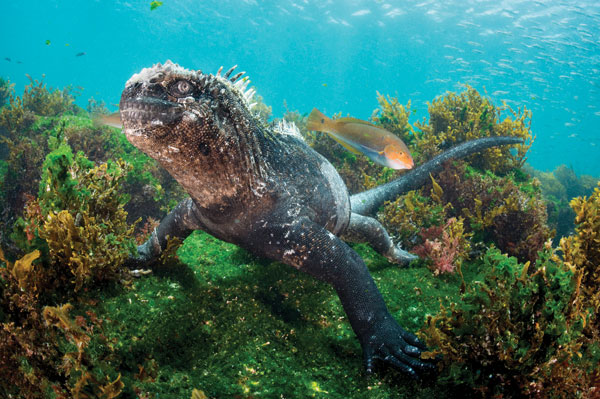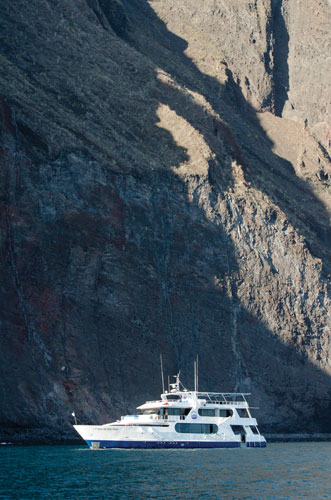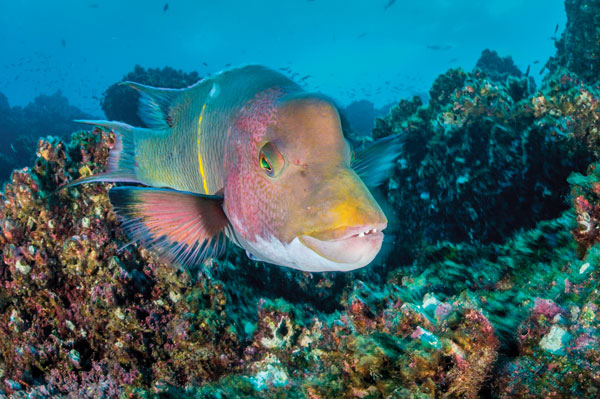Domain of the Sea Lizard
Words and Photography by Steve Jones

Sheets of shimmering silver wrap around me as I’m engulfed by a school of steel pompano so dense I cannot see the surface. The school parts as a turtle eases through the current towards me, followed by a squadron of eagle rays gliding in perfect formation above the stream of fish flowing over the reef. Unusual shapes emerge from the blue, as the hammerheads make their entrance into this dreamlike scene that unless you’ve been here, would take a healthy imagination to even believe. I am diving on Wolf Island and this is the Galápagos that I have long imagined.
Exceptional biodiversity is one of many reasons the Galápagos Islands are so fascinating for nature lovers and scientists alike, for there are few places on Earth that equal the sheer intensity of action found in the waters of Wolf and Darwin islands. These two remote northern outposts are the tip of an extinct sub-surface volcano that rises over 3280 feet (1000m) from the sea bed, with Darwin lying slightly further out than Wolf at around 100 miles (160km) north-west of the largest island, Isabela. Strong currents dictate that the diving is not for beginners, but for the experienced diver the rewards are huge. Darwin’s Arch, a rock formation that stands like a mythical portal to a realm of wonder beyond, has often been called out as the best dive in the world. There’s a reason for that. Entering the water, we drop like stones through the racing water. Waste time, and the reef will be gone in a flash. We shelter amongst rocky outcrops, careful to avoid the resident morays and I’m soon distracted by the attentions of the inquisitive hogfish, almost missing the main event unfolding behind me. Turning, I glimpse an unforgettable swagger moving up the reef toward the barberfish that wait like a racing pit crew to service their # 1 driver. Seconds pass, parasites are devoured, and the scalloped hammerhead shark peels off, moving to a holding pattern within the blue, as others approach for their own turn. Dozens of sharks hover in the distance then fade away like ships drifting into a sea mist. A fast, metallic rattle pulls me from my trance, and I see our guide launch into the blue pointing, seemingly, at nothing. I follow him on this blind chase, my breathing accelerating as the frantic swim continues, yet soon my faith that he can detect the unseen starts to wane as we see nothing, he must have been mistaken! No, he was not, a dark mass suddenly appears ahead on a collision course, seconds away. I raise the camera and the widest lens I have is soon filled with a goliath-sized whale shark at least 40 feet (12m) long. Passing within few feet (a metre), the immensely powerful tail propels the shark upstream, impossible for us to follow; however, several more encounters would follow on this dive. Low gas eventually sends me to the shallows where Galápagos sharks and hawksbill turtles cruise over a reef bustling with fish. The current sweeps us away and even then we are not alone, as curious silky sharks cruise in to investigate before losing interest as our zodiac approaches.

Sanctuary?
The vast richness of life in these waters led to their protection in March 2016, when the Darwin and Wolf Marine Sanctuary was announced by Ecuador’s president. This act banned extraction of natural resources in an area of 18000 square miles (46600 km2) in this and other selected areas around the archipelago, making it one of the largest safe havens for sharks in the world. Yet effectively policing such an area is near impossible. As recently as August 2017, an illegal Chinese fishing vessel was caught within the marine park, purely by chance. After a pursuit, the vessel was boarded and a horrifying find of over 6,600 shark carcasses led to the crew’s arrest and prosecution. The crew were jailed for their actions, yet with China being Ecuador’s largest backer and this region being rich in natural resources, the threat to these enchanted islands is constant. The hundreds of fishing vessels that orbit menacingly just outside the protected areas, as they also do in Cocos and other shark-rich areas, mean that unless there is more comprehensive enforcement of the protection, along with intervention from the Chinese government to tackle this problem at its root, it is inevitably a matter of time before the destruction of one of the most special and ecologically important places on Earth.
Galápagos straddles the equator at the centre of the western hemisphere, some 600 miles (965km) off the coast of Ecuador. Amongst the animals and plants found there and nowhere else are giant tortoises, Galápagos fur seals, and one of the world’s rarest birds, the flightless cormorant. The area was studied by Charles Darwin during the second voyage of HMS Beagle, and his findings here contributed to the theory of evolution by means of natural selection. Another unique inhabitant, the Galápagos marine iguana, is a living testament to this theory. Endemic to the islands and the only ocean-going lizard found on the planet, evolution has enabled these iguanas to feed on the algae that grows on submerged rocks, thereby tapping into an abundant food source in an environment that should be totally hostile to a cold-blooded lizard. Thought to have evolved from a common ancestor that drifted here on fallen vegetation from the American continent around 10.5 million years ago, the marine iguana diverged from the three species of land iguana several million years later, evolving a flattened tail that is perfect for swimming, sharp claws to keep from being swept from the rocks, and a short snout perfect for tearing off algae. Their dark skin enables them to absorb heat quickly when their cooled bodies sluggishly return from the sea. You will often see them sneezing, but they have not caught a cold from prolonged immersion; they are expelling excess salt, trapped by a special gland connected to their nostrils that has evolved for that very job!

Rich biodiversity
Our varied itinerary on the Galápagos Aggressor III brings us to the westernmost island, Fernandina. This is one of the most unspoilt areas, with no invasive species and visits that are strictly controlled to keep it that way, for the wildlife here already has enough natural threats to contend with: the active shield volcano ‘La Cumbre’ has erupted as recently as 2009! Our affable guide Walter describes this as the “warm day” of our trip, knowing it will be anything but, for it is here that the cold upwelling Cromwell current makes landfall with the islands, making the water here cold, green, yet incredibly rich in nutrients. We come to a stop at Cabo Douglas on the north west of the island, one of the few spots we are allowed to dive on Fernandina. Dark shadows cross our bow as sea lions and turtles swim, whilst in the background is a shoreline laced with iguana. A surreal scene unfolds underwater, where countless numbers of this sea lizard graze on the algae, unbothered by our presence, and huge green turtles cruise back and forth, yet our study of them is frequently interrupted by the playful sea lions vying for attention. Further out in deeper water, more strange creatures can be seen including the rarely sighted red lipped batfish and endemic Galápagos horned shark.
Without a sustained threat from predators the marine iguana has evolved few natural defences. It comes as no surprise that it is humankind that poses the biggest threat to this species, for over the centuries we have introduced cats, dogs, rats, and pigs to the islands, all of which prey on this docile animal and its eggs, wreaking havoc on the populations. Along with other threats, such as algae shortages during El Niño sometimes decimating populations, this species is yet another of the ever-growing list that is vulnerable to extinction. Yet it’s not all doom and gloom for the iguana, as evolution has again lent a hand to ensure this species is more resilient than meets the eye. During El Niño food shortages, they not only get thinner but also shorter, possibly due to their bodies feeding off their own bone structure, and they can alternate between growth and shrinkage throughout their lives, depending on food supply. This finding, first reported in the scientific journal Nature, is the first of an adult vertebrate able to shrink its body during times of famine. They also have been observed feeding off terrestrial vegetation when marine algae sources run low. This fascinating sea lizard it seems, may yet have a few evolutionary tricks up its sleeve.
Good to Know:
Getting there:
Fly to Ecuador. Guayaquil is the nearest international airport. Aggressor fleet can organise your regional flight with extra baggage allowance.
When to go: Year-round. January to May has warmer waters, calmer seas and the chance of seeing Manta Rays. June to December is cooler above and below water, often with poorer visibility but with the increased chance of seeing whale sharks.
Dive with: Galápagos Aggressor III (www.aggressor.com)
Dive details: Currents can be strong. Not for beginner divers. 7mm hooded semi-dry wetsuit recommended.







